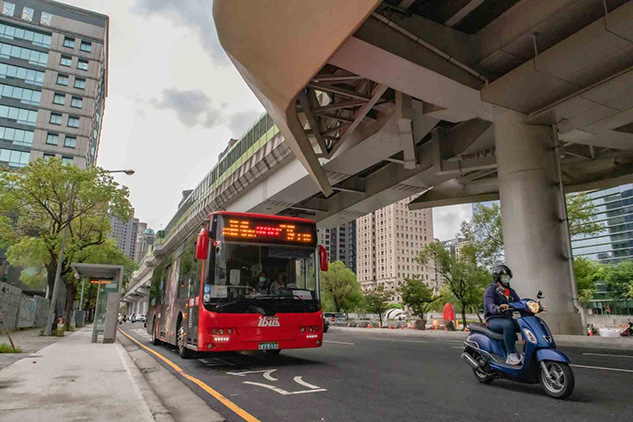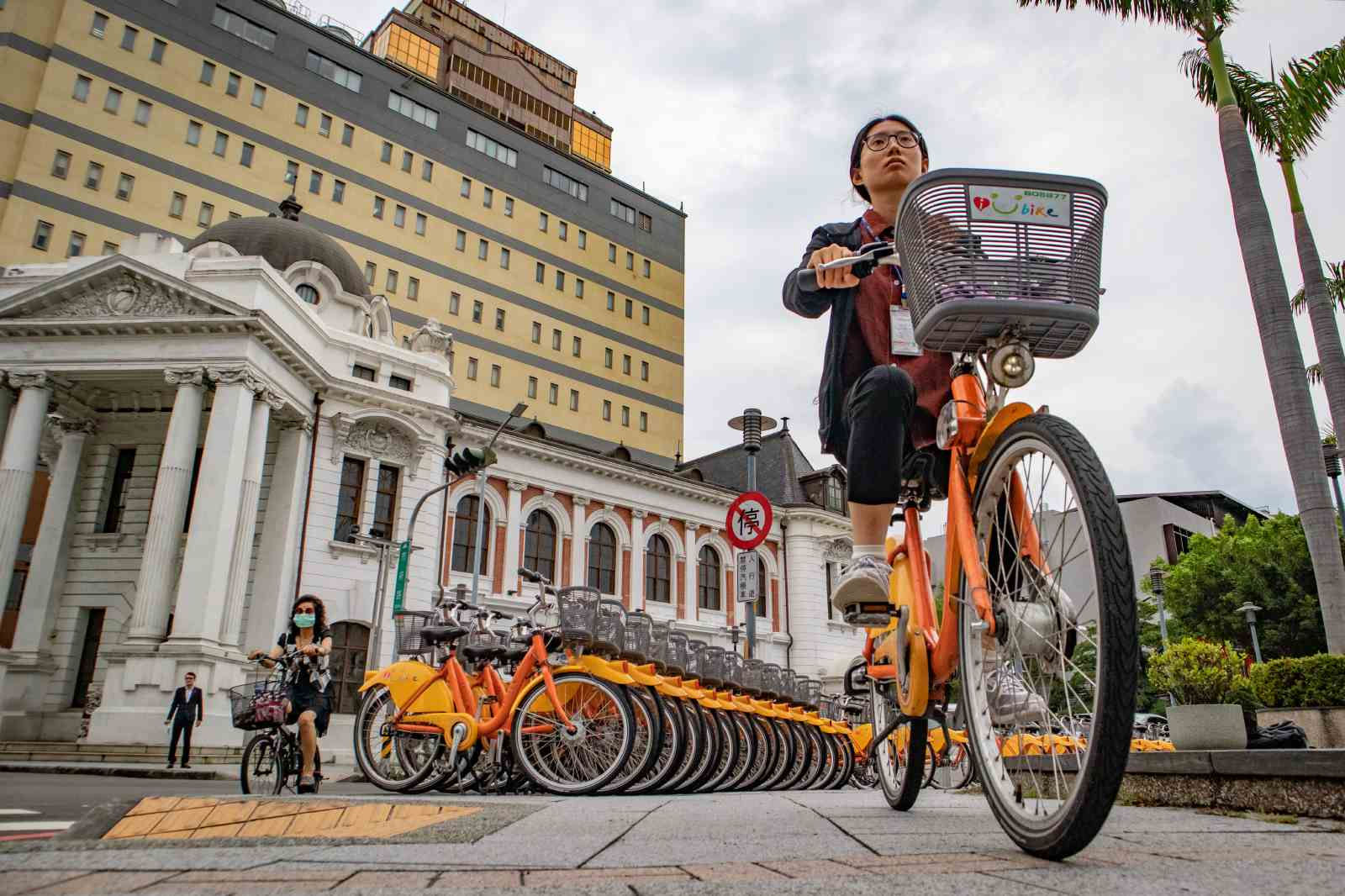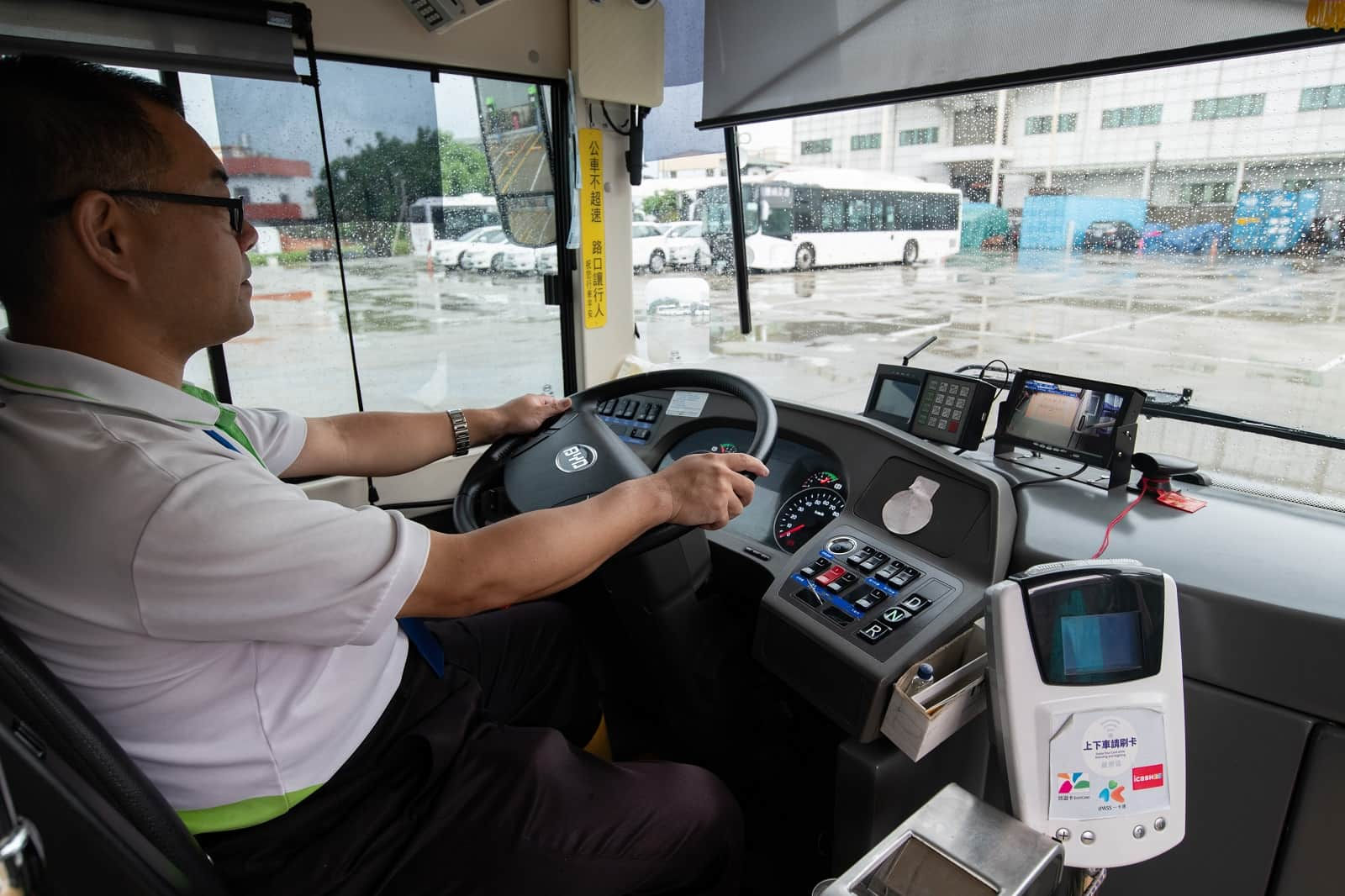Bye Bye Black Smoke and Diesel Odors
How Taichung Got the Greenest Bus System

Source:Ming-Tang Huang
Silent, emission-free electric buses have quietly become the new normal in Taichung, once notorious for its dirty public transport. Taiwan’s second-largest city used a mix of measures to turn the public bus system around. Today, Taichung has the highest number of electric city buses, encouraging neighboring Changhua County to follow suit.
Views
How Taichung Got the Greenest Bus System
By Yu-chen ChenFrom CommonWealth Magazine (vol. 700 )
It is near dawn, and the first specks of daylight are penetrating the night sky. A Taichung trash collection team and the owner of a breakfast store are already starting their day.
An electric bus serving Line 9 passes quietly without the noise and exhaust that make traditional diesel-powered city buses such a nuisance.
Yet Taichung did not shoot to fame as the city with the greenest bus system overnight. It took a concerted effort of industry, bureaucracy and academia that lasted almost 20 years to transform a rarely used, unloved mass transportation network into a popular and widely praised low-carbon transportation network.
Longtime Taichung residents still remember vividly that the city’s public transport system was stuck in a vicious cycle before the turn of the century.
Bus lines were not a lucrative business, as the locals preferred scooters or cars. As a result, bus line operators were not willing to invest in better service that could have enticed people to leave their cars and scooters in the garage. The buses were old and run-down, often emitting plumes of black, dirty exhaust. As soon as one passed the downtown area, the air reeked with the smell of diesel exhaust, making the bus an unattractive proposition.
“When we were growing up, the bus drivers were wearing undershirts and slippers,” recalls Yeh Chao-fu, director of the Taichung City Government’s Transportation Bureau. In the early days, two bus operators – Taichung Bus Co. Ltd. and Renyou Bus Co. Ltd. had carved up the public transport market between them. In the absence of true competition, quality was a far cry from what consumers desired.
Introducing New Competitors to Raise Quality
The situation changed only when Jason Hu, a career diplomat and former foreign minister, was elected Taichung mayor. Drawing from his experience during diplomatic postings abroad, he set out to improve the city’s public transport system both in terms of quality and quantity.
As Yeh points out, Hu’s main goal at the time was to convince more people to take the bus. Therefore, he brought in two new public bus operators - United Highway Bus Company Limited, widely known as Ubus, and Chuan Hang Bus Company Limited. “The two traditional operators protested vehemently; they even went on strike,” says Yeh.
The city government, however, did not back down, but demanded that the newcomers raise service quality.
“Everyone had to wear a dress shirt and a tie while driving,” explains Yeh. Although these new entrants were initially only allowed to service lines in the city’s less populated periphery, they soon built a good reputation. Consequently, the public began to demand that the city government open more lines. Feeling pressure, the traditional operators feared they would be squeezed out of the market if they did not transform. Therefore, they put in some effort to improving the passenger experience and making bus commutes more appealing.
Yet these efforts still failed to bring the masses to the buses, and it remained a mass transportation network in name only. After the merger of Taichung City with neighboring Taichung County as part of wider administrative reform in 2010, the Taichung City Government introduced a “8-kilometer free fare” policy. This meant that the city government paid for the first eight kilometers of a trip on a city bus, an offer that many residents readily took.
At the same time, new bus lines were added that ran across the former border between city and county. This brought operators into the Greater Taichung market that had previously only served the Taichung County area. Likewise, bus operators from neighboring Changhua County were allowed to extend their services to Taichung City, and new routes serving the high-speed railway station in Taichung’s Wuri District were opened.
Lin Han-bin, director of the Department of Public Works of Changhua County, points out that in the early days the Taichung bus operators were most denounced for refusing to let some of their routes go. On top of that, the Taichung City Government also defended its territory, rarely opening routes up to operators from cities and counties outside the city. But the situation has improved.
A growing number of operators entered the city bus market in Taichung. But what failed to improve was the smelly, polluting bus exhaust that was increasingly impossible to ignore given the pressing need to reduce greenhouse gas emissions.
At the time, reducing carbon footprint was a hot topic around the world, sparking the central government to designate 2010 as “energy saving and carbon reduction year”. Taichung took the lead among the municipalities at the time by passing the Taichung City Autonomous Regulations for the Development of a Low-Carbon City and establishing a Low-Carbon City Promotion Office.
On the transportation side, Taichung was planning to turn the Shuinan Economic and Trade Park, a brownfield redevelopment on the site of the former Shuinan Airport, into a pilot zone that would restrict the use of gasoline vehicles. But the plans triggered public protest.
The ensuing public debate firmly implanted low-emission transportation, at the time quite a far-sighted concept, into the city’s DNA.
Higher Subsidies Make Taichung E-Bus Leader
In 2011, electric buses hit the market in Taiwan, and bus operators started to introduce them into their fleets. When Lin Chia-lung was elected mayor in late 2014, he extended the 8-kilometer free ride scheme introduced by his predecessor to 10 kilometers. At the same time, the focus of local transportation policy shifted from creating a mass transportation network to creating a low-carbon transportation network.
In late 2015, Jasun Bus Transportation Co. Ltd. was founded, the only operator in central Taiwan with a fully electrical fleet of 46 e-buses. They chose to enter the market at the time, lured by central government subsidies for e-buses and the prospect of gaining a competitive edge thanks to lower operating costs.

Jasun Bus manager Wang Po-jen, who previously worked for another bus company, explains that electricity costs for charging an e-bus amount to around NT$30,000 per month at most. Based on a price of NT$20 per liter of diesel fuel, fuel costs for a conventional bus thus by far exceed the electricity costs of an e-vehicle.
It is a different story, however, if one factors in vehicle procurement costs. An e-bus costs around NT$10 million to NT$15 million, whereas a conventional diesel bus comes with a NT$4.5 million price tag. This means by investing the amount needed to buy one e-bus, an operator could procure two conventional buses and would still have money left.
However, the Ministry of Transportation and Communications earmarks NT$500 million a year to subsidize the procurement of electric buses to encourage operators to phase out diesel buses. Per e-bus, the government pays up to NT$6.5 million in subsidies, roughly half of its price. These measures eased the financial pressure on Jasun Bus, facilitating the decision in favor of e-buses.
At the same time, the Taichung City Government increased its operating subsidies for e-buses to give operators more incentive to make the transition.
This became necessary to enable operators to turn a profit. Because although the e-buses are cleaner, their ticket price was the same as that of polluting fossil fuel buses. On many routes, passenger volume was not enough to cover costs.
This also posed a problem for other operators. Despite rising bus traffic volume, the reasonable costs per kilometer determined by the Taichung City Government stood at just NT$38.3, the lowest amount among the six special municipalities, whereas the actual costs per kilometer reached NT45, so that it was not possible to break even, much less make a profit.
As a result, the bus operators in central Taiwan were hesitant when it came to buying e-buses. That’s why the Taichung City Government eventually raised operating subsidies for e-buses to NT$60 per kilometer, 1.5 times what it pays for diesel buses.
“Taichung is the first city in Taiwan to reevaluate the operating costs of e-buses,” notes Lee Ker-tsung, deputy convener of the transportation group of the Consumer’s Foundation. As the subsidy system was fleshed out, operators became more confident about using e-buses. Presently, Taichung has nearly 200 electric buses, the highest number of any municipality in Taiwan.
The local craze for e-buses has also reached Changhua. Late last year, the Changhua County Government invited tenders for the operating rights of a direct express route between the Changhua Railway Station and the long-distance bus complex at Chaoma Station in Taichung. In addition to two existing operators, Chung-Lu Bus Traffic Co. Ltd., based in Lugang, participated in the tender in what was their first sortie into the Changhua City bus market, and they won the tender. Now they are operating the one and only e-bus in Changhua, making the Changhua Station-Chaoma Station stretch the only e-bus route in the entire county.
The effect that this development had on other operators is already becoming visible as some are interested in joining the e-bus procurement drive.
However, even though central Taiwan has been more aggressive in promoting low-carbon transport, the region still has a long way to go if it wants to reach the central government’s goal of phasing out conventional buses and switching to fully-electric bus fleets in downtown areas by 2030.
Extended Lifespan for E-Buses Being Mulled
Lee points out that if all 12,000 city buses in Taiwan were to be replaced by electric vehicles by 2030, then at least 900 e-buses would have to be added every year. The current number is around 80. Even Taichung, which has more e-buses than any other municipality, is nowhere near it.
If the central and local governments want to convince operators that the transition to e-mobility is worthwhile, they must first of all extend the vehicle lifespan. Currently the central government stipulates that e-buses must be replaced after eight years in service. Under Taichung’s Autonomous Regulations, the lifespan has been prolonged to 12 years.
Wang points out that diesel buses must be rotated out of operation after six to eight years, mainly because of emissions and environmental concerns. But an e-bus only needs to meet safety standards. “Basically, you only need to replace the battery to have a new bus,” he says.
Such an approach still hinges on a comprehensive assessment system. Lee notes that the Ministry of Transportation and Communications currently investigates relevant methods, compiling information on the operational status of different electric vehicles over the past nine years, to serve as a basis for assessment.
Upcoming Opening of MRT Line a Good Opportunity
County and city governments can also use the bus route rights that they control as a carrot to encourage operators to buy more e-buses.
When Taichung’s first mass rapid transport line, which is 16.71 km long and comprises 18 stations, begins operations as scheduled this November, demand for shuttle bus services will increase greatly. A 5.33-km MRT extension to Changhua is already being planned. “When the time comes, we don’t rule out making e-bus a requirement in our evaluation criteria,” says Yeh.
As currently only 12 percent of the city’s residents actually use mass transportation, there is much room for growth.

“If we can push this to 20 percent, it would mean that one out of five Taichung residents takes mass transportation,” Yeh calculates. For the bus operators this would translate into an income increase of 30 percent to 40 percent. In other words, they might buy more e-buses.
At the upper level, the central government’s efforts to adjust the energy structure from gasoline to electric vehicalsis already slowly getting there. Now it remains to be seen how Taichung and Changhua will build on the efforts of the past two decades to create even more sustainable low-carbon transportation networks.
Have you read?
♦ Does Your Place Have a Breeze? Invisible ‘Breeze Rights’ Can Impact Your Electricity Bill
♦ How Can Solar Power Arrays Co-exist with Nature?
♦ Will a 20-Year-Old Forest be Chopped Down to Produce Solar Power?
♦ Activist Mothers in Hsinchu Fight for Clean Water – Do Microchips Matter More than People?
♦ Post COVID-19, Time to Make Peace with Our Earth
Translated by Susanne Ganz
Edited by TC Lin
Uploaded by Judy Lu






